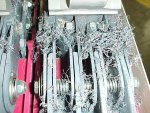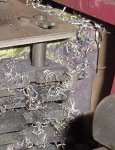netphish
Member
- Location
- Los Alamos, NM
We recently were able to get into and old 60's era GE Metal-enclosed switchgear to take a look a the buss configuration. We have an un-provisioned cubical that we would like to extend buss into, but we want to ensure the buss has the required current-carrying capacity for our application. The horizontal buss was all bare copper but the vertical buss was shiny silver in color. We could only see it through a small hole around the load side of the breaker but it looked much like a solid piece of extruded aluminum buss measuring 3/8 x 4". The vertical buss is supposed to be rated for 1600amps.
Question, is there a way to verify the construction of the buss so we can determine the current-carrying capacity? There were surface scratches on an edge and I didn't see copper showing through. Thanks, Chris
Question, is there a way to verify the construction of the buss so we can determine the current-carrying capacity? There were surface scratches on an edge and I didn't see copper showing through. Thanks, Chris



